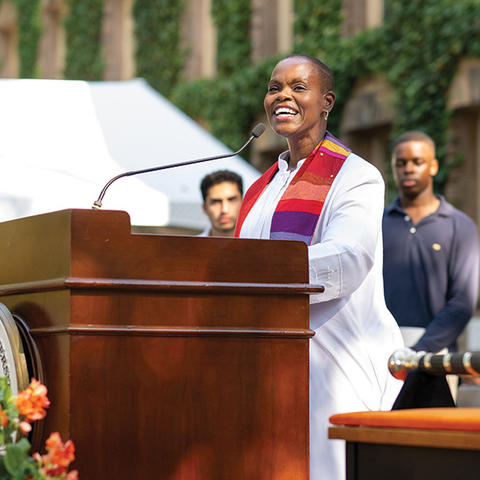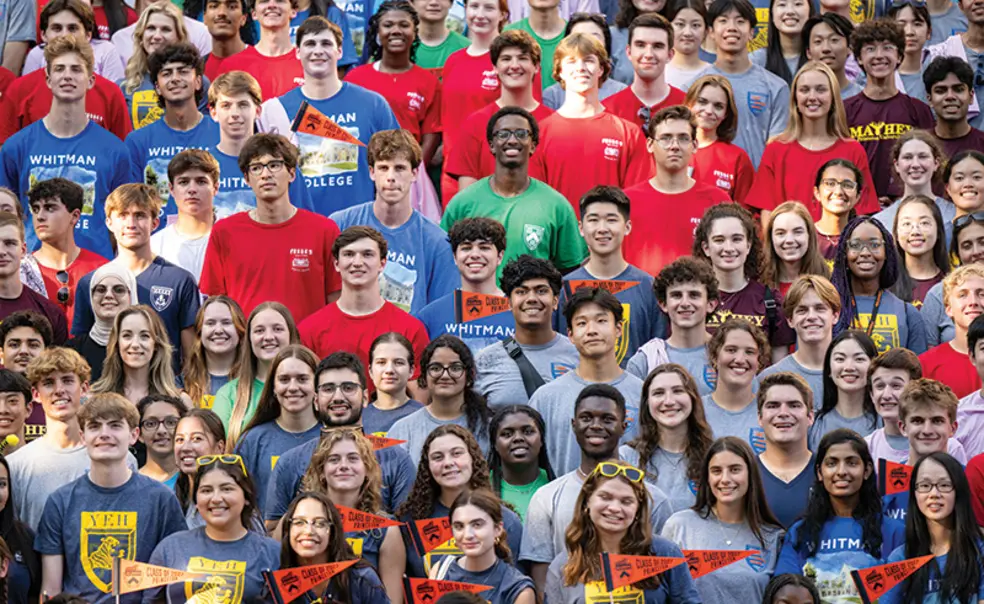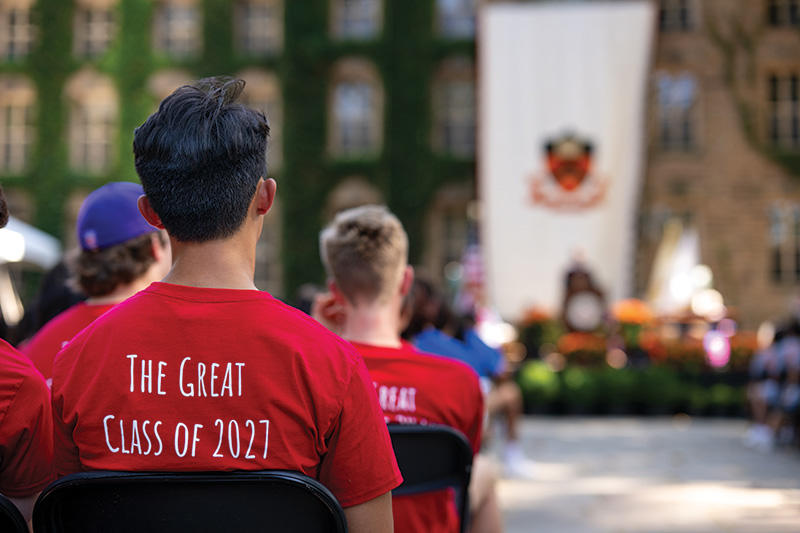New School Year Kicks Off With Orientation and Opening Exercises
“Always, and especially now, this campus must stand firmly for equality, inclusion, and respect,” President Christopher Eisgruber ’83 said at Opening Exercises
Though classes didn’t start until September, Princeton’s campus was full of hundreds of new students in late August who arrived early to attend orientation events where they bonded with one another, acclimated to campus, and learned about their home for the next several years.
The University welcomed 1,366 undergraduates in the Class of 2027, 33 undergraduate transfers, and 763 graduate students (see sidebar for more about the new arrivals).
As a history buff, Susan McLernon ’26, a military veteran and transfer student, was keen to walk around campus and soak it in. She’s making history herself as she told PAW she’s the oldest undergraduate currently on campus (she’ll turn 41 in December). “At first it was a little daunting, but now I’m like, I can pave the way for other older students to come and fulfill their dreams and get an education,” she said. “Honestly, every single first-year I have met since I got on campus is brilliant and stunning and marvelous, and I’m excited to be able to be part of their journey as much as [I’m] taking a journey myself.”
Orientation activities included the annual Pre-rade; Outdoor Action (OA), a program that sends students outdoors; Community Action (CA), a service-oriented program coordinated by the Pace Center; and Dialogue and Difference in Action (DDA), which centers around conversations on identity, power, privilege, and difference.
Sherly Zhu ’27 took part in an immigration-focused CA experience where she played board games with children of refugees and packaged and distributed food. “My parents are immigrants, and I feel it’s really important to stay in touch with these communities so you really know what the need is, because it can be really easy to lose sight of that when you’re in a classroom learning about it theoretically,” Zhu said.
Yan Zhen Zhu ’27, who took part in OA at base camp, said “sleeping under a tarp was not ideal, but it was beautiful seeing the waterfalls and bonding with other people.”

Freedom of speech continued to be a hot topic on campus. At the Opening Exercises ceremony, President Christopher Eisgruber ’83 said, “Always, and especially now, this campus must stand firmly for equality, inclusion, and respect. Our community must be a place where students, faculty, and staff of all identities feel fully welcome, free to express themselves, and able to participate fully in the transformational educational experiences that Princeton offers.”
First-years also attended a conversation between Eisgruber and Anthony Romero ’87, executive director of the American Civil Liberties Union, about the importance of academic freedom and freedom of expression. Romero said he believes free speech is foundational for personal fulfillment and “essential to the workings of a democracy,” so even the harshest speech merits protection.
This year’s Pre-read, How to Stand Up to a Dictator: The Fight for Our Future, was written by Maria Ressa ’86, a recipient of the 2021 Nobel Peace Prize and founder, CEO, and executive editor of Rappler.com, a news site based in the Philippines. Ressa, who is an outspoken critic of some Filipino policies and politicians, has faced lawsuits and the threat of jail time due to her work, though she continues to speak out. Eisgruber and Ressa discussed her book during the annual Pre-read assembly in Jadwin Gymnasium the evening after Opening Exercises.
New graduate students took part in their own orientation activities, such as the student organization fair, where 45 groups were represented, and an information fair and lunch, where Gary King ’79 of the Princetoniana Committee taught the locomotive cheer to groups of students throughout the hourlong gathering.
When PAW spoke with the University’s newest students Sept. 3, “excited,” “overwhelmed,” and “homesick” were commonly repeated sentiments.
Amid the festivities, some were already eager to start the next part of their Princeton journey.
“Honestly, I have been waiting for classes to start,” said Aakansh Yerpude ’27.
“It’s been a fun week and a half just getting to know everyone, but it’ll be good to settle into a routine and kind of get into a normal life,” said Jack Noymer ’27.
BY THE NUMBERS
UNDERGRADUATE CLASS OF 2027
Applicants: 39,644
Admitted: 1,782 (4.5%)
Enrolled: 1,366
Asian American: 26%
Black or African American: 9%
Hispanic or Latino: 10%
Multiracial: 7%
American Indian or Alaska Native: <1%
Native Hawaiian American or Other Pacific Islander: <1%
International students: 14%
Children of alumni: 13%
Qualified for financial aid: 66%
Eligible for Pell Grants: 22%
First-generation college students: 17%
Bachelor of science in engineering students: 29%
TRANSFER STUDENTS
Enrolled: 33
From community colleges: 24
Military (reservists or veterans): 21
First-generation college students: 24
GRADUATE STUDENTS
Applicants: 14,577
Admitted: 1,369 (9.4%)
Enrolled: 763
Doctoral-degree students: 549
Master’s-degree students: 214
Humanities and social sciences: 348
Natural sciences and engineering: 415
International students: 354
Among U.S. students
From underrepresented racial or ethnic groups: 21%
From first-generation or low-income backgrounds: 25%
Sources: Office of Communications, School of Engineering and Applied Science













No responses yet